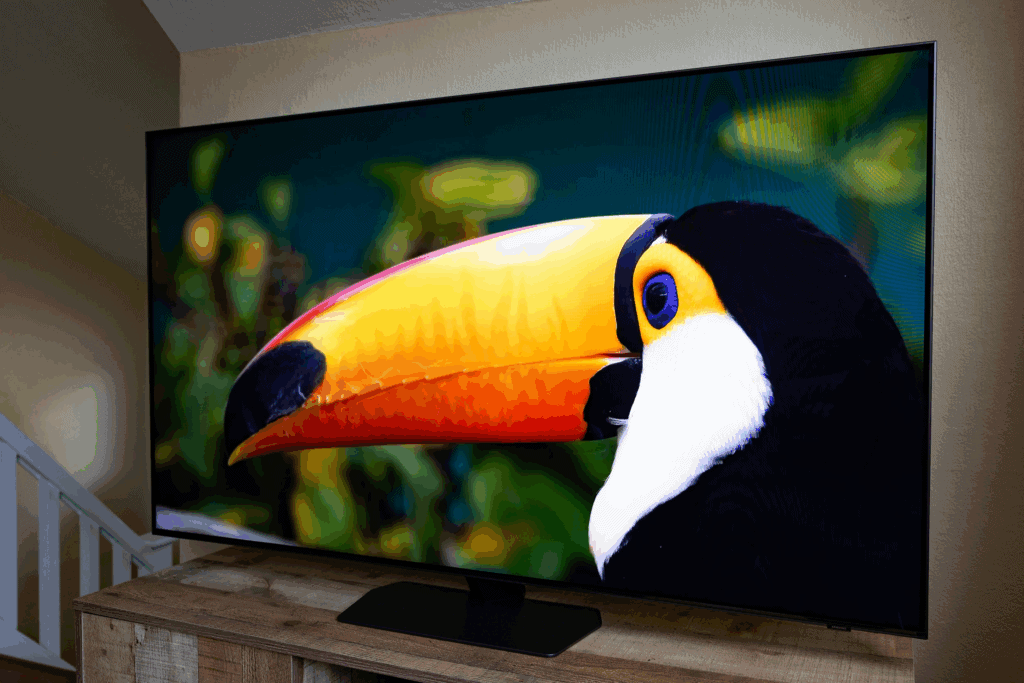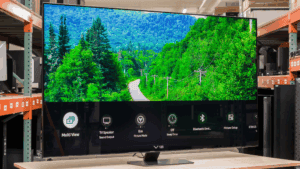The Samsung QN90C QLED TV is marketed as a top-tier 4K television with impressive specs: Mini LED backlighting, vibrant HDR performance, and advanced picture processing. On paper, it looks like a premium powerhouse. It garners plenty of praise for its brightness, color accuracy, and sleek design. But dig a little deeper, and a number of downsides begin to surface, ones that buyers should seriously consider before dropping several thousand dollars. This post cuts through the hype to explore the real-world drawbacks of the QN90C.
Table of Contents
- 1 No One Connect Box: A Step Backward in Installation Cleanliness
- 2 Tizen OS: Clunky, Ad-Heavy, and Annoyingly Intrusive
- 3 No Dolby Vision: A Glaring Omission in HDR Capability
- 4 Mediocre Native Audio: A TV This Price Should Sound Better
- 5 Expensive Price Tag: Premium Cost Without Universal Premium Features
- 6 Stand Design: Wobbly and Inadequate Cable Management
- 7 Remote Control: Sparse Buttons and No User-Serviceable Battery
- 8 Anti-Glare Coating: A Trade-Off with Noticeable Side Effects
- 9 Gaming Mode: Brightness Overload at the Cost of Detail
- 10 Final Thoughts: A Mixed Bag for a Premium Price
No One Connect Box: A Step Backward in Installation Cleanliness
One of the surprising omissions from the QN90C is Samsung’s One Connect Box, a feature that routes all cables through a single external hub, allowing for a tidy, almost cable-free setup. Instead, the QN90C requires you to plug HDMI, power, and other cables directly into the back of the TV.
For wall-mounted setups, this can be frustrating. Instead of tucking away messy wires in a cabinet or routing them neatly through a stand, users are left with dangling cords that break up the illusion of a floating screen. If you’re investing in a high-end aesthetic, this lack of streamlined cable management is a letdown. It’s especially jarring when you consider that some lower-tier Samsung models still include the One Connect Box.
For those who value a clean, minimalist look in their living space, this design choice feels like a miss—and a surprising one at this price point.
Tizen OS: Clunky, Ad-Heavy, and Annoyingly Intrusive

Samsung’s Tizen OS has been criticized for its latest overhaul. While it’s functional, it’s not exactly user-friendly. Navigating the settings often requires a deep dive through menus, and it’s easy to get lost if you’re not already familiar with Samsung’s ecosystem.
Worse, Tizen has become extremely ad-heavy. On boot-up, the TV often defaults to Samsung’s free ad-supported streaming (FAST TV) channels, think Nickelodeon or random news networks, which feels jarring and intrusive. It gives the impression that the TV is prioritizing Samsung’s content partnerships over the user experience.
Several users have compared it unfavorably to the streamlined interfaces of competitors like Apple TV. Accessing full settings, adjusting calibration, or even switching inputs often takes more clicks than it should. For a TV that’s supposed to be premium, the software experience feels more like a budget model trying to monetize every corner of the interface.
No Dolby Vision: A Glaring Omission in HDR Capability
The QN90C supports HDR10, HLG, and HDR10+, but not Dolby Vision. For many consumers, this is a dealbreaker. Dolby Vision is widely considered the gold standard for dynamic HDR, offering more nuanced color and brightness control on a scene-by-scene or even frame-by-frame basis.
Content shot in Dolby Vision will still play on the QN90C, but it defaults to HDR10, which simply isn’t as precise. If you’re a cinephile with a keen eye for visual detail, the lack of Dolby Vision means you’ll miss out on what could be a richer viewing experience. Major streaming platforms like Netflix, Disney+, and Apple TV+ heavily feature Dolby Vision content, making its absence even more noticeable.
Samsung’s loyalty to its proprietary HDR10+ format feels out of step with the industry, especially when competitors like LG and Sony offer both standards. In 2025, locking users into one HDR format is a limitation, not a feature.
Mediocre Native Audio: A TV This Price Should Sound Better

The QN90C’s audio is serviceable but far from stellar. While it does include Object Tracking Sound (OTS) and can get reasonably loud, the sound lacks richness and depth. Dialogue clarity can suffer in complex soundscapes, and bass is notably weak.
Samsung’s solution? Buy a soundbar. And not just any soundbar, preferably one of their Q-series models, so you can use their Q-Symphony feature, which merges the TV’s speakers with the soundbar’s for a fuller effect.
That’s an additional cost on top of an already expensive TV. While this may be par for the course in modern slim televisions, it’s disappointing given the premium tier the QN90C occupies. At nearly $2,800 for a 65-inch model, “decent” sound isn’t enough.
Speaking of price, the QN90C doesn’t come cheap. The 65-inch variant retails for around $2,799.99 in the US and £2,800 in the UK. That’s a significant outlay, especially when competitors like TCL and Hisense are pushing aggressively into the high-performance space at a fraction of the cost.
For many buyers, that price premium doesn’t feel entirely justified. When you factor in the absence of Dolby Vision, middling audio, and a cluttered UI, the QN90C starts to seem overpriced. You’re paying for brightness and contrast, yes, but you’re also paying for things you don’t get, like a One Connect Box or top-tier HDR compatibility.
There are certainly reasons to consider this TV, but value for money isn’t one of them.
Stand Design: Wobbly and Inadequate Cable Management

The QN90C uses a central pedestal-style stand, which saves space on your furniture but comes with trade-offs. While the wobble isn’t severe, it’s definitely noticeable, and more than you’d expect from a TV in this class.
More frustrating is the cable management system built into the stand. The channels meant to conceal wires are narrow, often too thin for thicker HDMI cables or even power cords. As a result, users may find themselves improvising with cable ties or running wires externally, defeating the purpose of the integrated design.
This feels like a step back from earlier models that prioritized stability and smarter wire routing. For users not wall-mounting their set, this design could be a daily annoyance.
Samsung’s minimalist remote has become a staple of its modern TVs, but it’s not without drawbacks. The button layout is sparse, which forces users to dig into the UI for even basic functions like switching inputs or adjusting picture settings.
On top of that, the remote uses a rechargeable battery that isn’t user-replaceable. Once the battery starts to degrade, as all lithium-ion batteries eventually do, you can’t just pop in a new one. You’ll either need to replace the entire remote or live with diminished battery life.
For a TV in this price range, this lack of longevity and usability feels unnecessarily restrictive. Convenience shouldn’t come at the cost of user control.
Anti-Glare Coating: A Trade-Off with Noticeable Side Effects

Samsung made changes to the anti-glare technology on the QN90C, particularly to minimize the “rainbow sheen” effect found on earlier models. In doing so, they switched to an ADS-type LCD panel (a variant of IPS), which improves viewing angles.
But there’s a trade-off: the anti-glare coating isn’t as effective. In bright rooms or with overhead lighting, noticeable reflections still occur. While the off-angle viewing is better, those reflections can be distracting and reduce overall image fidelity.
For a TV that’s supposed to excel in all lighting environments, this is a notable shortcoming. If you watch TV during the day or in a well-lit room, you’ll likely encounter glare that undercuts the otherwise excellent picture quality.
Gaming Mode: Brightness Overload at the Cost of Detail
The QN90C is marketed as a gaming-friendly TV, with features like low input lag and HDMI 2.1 support. But the dedicated gaming picture preset doesn’t live up to expectations.
Backlight control seems less precise in game mode, often resulting in over-brightened images. This can wash out highlights and reduce dynamic range, an ironic flaw for a display that touts its HDR capabilities.
While the latency is solid, the visual fidelity takes a hit. Gamers expecting a perfectly calibrated image right out of the box will likely be disappointed and may need to spend time tweaking settings manually to dial it in.
The Samsung QN90C QLED TV has a lot going for it: incredible brightness, solid build quality, and Samsung’s reputation for durability. But when examined critically, it also comes with a list of compromises that are hard to ignore.
From the missing One Connect Box to the lack of Dolby Vision, from mediocre audio to a cluttered interface, this TV asks a lot of money while cutting corners in areas that matter to many users. It’s not a bad TV by any means, but it’s far from flawless. For those weighing their options in 2025, it pays to look beyond the spec sheet and consider how these drawbacks might affect your day-to-day experience.
Nevertheless, if you’ve weighed all these drawbacks. Still wish to go with the purchase, congratulations! You’re making a considered decision that you won’t regret.
Reference:
https://www.youtube.com/watch?v=bOgSjABfTPg&pp=ygUVU2Ftc3VuZyBRTjkwQyBRTEVEIFRW
https://www.youtube.com/watch?v=AhLaTV37ubg&pp=ygUVU2Ftc3VuZyBRTjkwQyBRTEVEIFRW
https://www.youtube.com/watch?v=cv5apu8XAJU&pp=ygUVU2Ftc3VuZyBRTjkwQyBRTEVEIFRW0gcJCbEJAYcqIYzv
https://www.youtube.com/watch?v=TbUaofTsGcE&pp=ygUVU2Ftc3VuZyBRTjkwQyBRTEVEIFRW
https://www.youtube.com/watch?v=nzdwQGIUUw4&pp=ygUVU2Ftc3VuZyBRTjkwQyBRTEVEIFRW
Samsung QN90C QLED TV

The Samsung QN90C QLED TV is marketed as a top-tier 4K television with impressive specs: Mini LED backlighting, vibrant HDR performance, and advanced picture processing. On paper, it looks like a premium powerhouse. It garners plenty of praise for its brightness, color accuracy, and sleek design. But dig a little deeper, and a number of downsides begin to surface, ones that buyers should seriously consider before dropping several thousand dollars. This post cuts through the hype to explore the real-world drawbacks of the QN90C.
Product Currency: USD
Product Price: 3500
Product In-Stock: InStock
4


